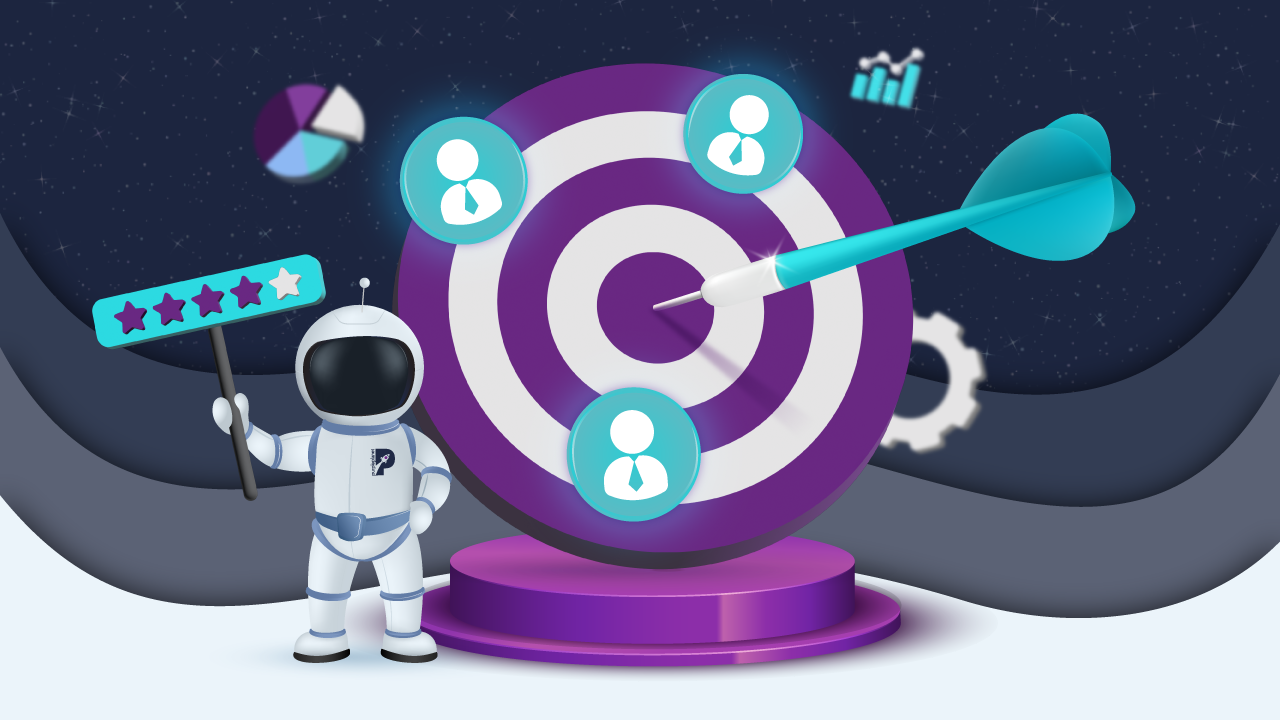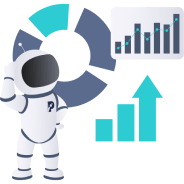

Lead Scoring: What It Is and Why It Matters
What is lead scoring?
Lead scoring is all about assigning value to different potential customers.
It’s a methodology that ranks some leads above others in terms of how valuable they could be to businesses.
Lead scoring is used by businesses to evaluate and rank potential customers (leads) based on their likelihood of becoming paying customers. Each lead is analysed for certain criteria (e.g., behaviour, demographic, and engagement) and assigned a value or score based on these factors.
Lead scoring can help businesses focus their sales and marketing efforts by highlighting which leads are most likely to convert due to their apparent engagement or interest levels. Ultimately, this process allows for more efficient use of resources and can ultimately lead to increased sales and revenue.
There are numerous other benefits to lead scoring, which we’ll delve into below. This article will also explore the various ways businesses can conduct lead scoring, as well as some dos and don’ts.
Let’s get started.
Why should I start lead scoring?
Once your business starts implementing lead scoring, you can expect to see the following results:
Better prioritisation of sales and marketing efforts
As mentioned above, lead scoring helps businesses identify the most promising leads. This helps them focus their sales and marketing resources on those individuals who are most likely to make a purchase, ultimately saving time and money by avoiding wasted efforts on leads that are less likely to convert.
Improved ROI
By streamlining their resources on the most promising leads, businesses often see increases in their return on investment (ROI) for sales and marketing efforts. In fact, organisations using lead scoring experience a 77% increase in lead generation ROI.
Improved lead conversion rates
Businesses using lead scoring also see increased conversion rates (CR). By focusing on leads that are most likely to convert, a higher percentage of those targeted will ultimately become paying customers. A boosted CR also means that businesses are spending less time, money, and energy on lead generation.
More personalised communication
A key component of lead scoring is understanding the needs and preferences of individual leads, allowing businesses to communicate with customers in a more personalised and relevant way. This is known to build stronger relationships with customers and increase the chances of converting them to paying customers.
Increased customer satisfaction
Since lead scoring means that B2C communication is better tailored to the specific needs of individual leads, businesses can see boosted customer satisfaction levels. This is because customers feel that a business understands their needs and preferences, which can encourage them to recommend the brand to friends and become repeat customers.
Overall, conducting lead scoring can provide significant benefits for businesses by helping them to better understand their customers and focus their resources on the most promising opportunities.
If you’re convinced and want to kick start a lead scoring campaign, read on to learn how you can do so:
How do businesses conduct lead scoring?
Lead scoring is typically conducted with a combination of automated tools and human analysis. Here are the steps typically involved in the process:
1. Determine which data is important to your business
Businesses first need to determine the criteria that are most relevant to their specific goals. Doing this will help identify which data is relevant to their lead scoring efforts because it will inform the factors that leads will be scored on.
For example, the online behaviour of website visitors could be really important to an e-commerce business, while a local business could be more interested in location data. These criteria will then inform scoring in that users who engage more with a website will receive a high score and leads that live outside a catchment area will receive a low or negative score.
Here are some other examples of data that could form the basis of your lead scoring efforts:
- Demographic information (e.g., age, gender, location)
- Company information (e.g., if B2B, industry)
- Online behaviour (e.g., webpages visited, downloads, forms filled, purchase and browsing history)
- Email and social media behaviour (e.g., open rates, clickthrough rates, shares, likes, follows, retweets)
Lead scoring typically involves a combination of both explicit (information provided by the lead) and implicit data (gathered through the lead’s behaviour), so don’t feel pressured to pick just one.
If you’re not sure which data will be most important to your lead scoring efforts, you can get help by involving your sales team in the discussion, conducting customer surveys, and looking at customer-acquisition data reports.
Your sales team and customers will know lots about the sales process and, therefore, what was and wasn’t effective in driving sales. Plus, your analytics report will give concrete answers to questions regarding conversion and help identify the most common traits among converting customers.
2. Create a value range
Once the criteria are identified, each one is assigned a value range. For example, if multiple purchases are an important factor for your business, you’ll create a corresponding range. In this instance, you might set up your value range like this:
1 purchase = 10 points, 2 purchases = 20 points, 3 purchases = 30 points, and so on.
You might create a multifaceted value range based on several factors. For instance:
Filling a form = 10 points, mailing list sign-up = 15 points, visiting a high-value page = 20 points
There are countless ways you could set up your value ranges. Just make sure that high points are only awarded to factors that are proven to be valuable to your business and that points are awarded proportionately in accordance with your conversion analytics.
For instance, if users that signed up to your mailing list proved to be more valuable than those who just made an account with your e-commerce site, don’t award the latter more points.
3. Score your leads
Using the criteria and ranges you have established, it’s time to score each lead according to their behaviour and characteristics. This can be done using an automated lead scoring tool that aggregates data from various sources, or it can be done manually by a sales or marketing team member.
For large datasets, an automated tool is most efficient, and it will sync up with your CRM software so everything’s in one place.
4. Start prioritising leads
Once leads have been scored, you can start prioritising them. The leads with the highest scores are typically given the most attention and resources, as they are considered to be the most likely to convert to paying customers.
A great way to celebrate your new lead scoring efforts would be to launch a highly targeted email marketing campaign on your smaller but more qualified list of leads. Or you might just carry on with your sales and marketing efforts but trim down the list of people you intend to reach out to.
5. Adjust your criteria and scoring as time goes on
Over time, businesses may need to adjust their lead scoring criteria and value ranges based on changes to their goals, customer behaviour, or the state of the market. By doing so, they can remain relevant and in tune with customers even as things evolve. We recommend evaluating your lead scoring process if sales or conversions suddenly take a downward turn or if you open up a new marketing channel (e.g., create a company social media account).
Different lead scoring models
Depending on their specific needs and goals, businesses can choose from a few different lead scoring models. Here are three to be aware of:
1. Rule-based model
The rule-based model involves setting up a set of predefined rules to score leads. These rules can be based on various criteria, such as those listed above.
This model is useful for businesses that have a clear understanding of their ideal customer profile and want to focus on those who meet specific criteria. However, it’s limited in its ability to capture complex relationships between different lead attributes.
2. Predictive model
The predictive model involves using machine learning algorithms to analyse historical data and predict the likelihood of a lead converting.
This model is particularly useful for businesses that have large volumes of data and want to leverage it to make more accurate predictions. The model can be trained to look for patterns in datasets that are indicative of a lead being more likely to convert and then use this information to score leads.
3. Hybrid model
The hybrid model is a combination of both rule-based and predictive models. It involves setting up predefined rules as well as using machine learning algorithms to identify patterns in the data.
This model is useful for businesses that want to leverage the benefits of both models. They’ll likely have some predefined rules in place, such as the examples listed in our “how-to” section.
Lead scoring Dos and Don’ts
If you’re going to embark on lead scoring for the first time, there are some things you’ll need to know. Here are our top dos and don’ts for lead scoring:
Don’t rely solely on one source of data
It’s important to consider multiple sources of data when scoring leads. Relying solely on one type of data, such as demographic or behavioural, may result in an incomplete picture of each lead’s potential. Instead, make sure you combine the information from both types for a more comprehensive approach.
Don’t use subjective or arbitrary criteria
Lead scoring criteria should be based on objective data that is measurable and relevant to your business goals. Using subjective or arbitrary criteria can lead to inconsistent and inaccurate lead scoring. Instead, the criteria used to score leads should be clearly defined from the very beginning.
Don’t set it and forget it
Lead scoring should be an ongoing process that is regularly evaluated and adjusted as needed. Setting the criteria and then never revisiting them can lead to an outdated and ineffective scoring methodology.
Don’t ignore negative scoring
Negative scoring is a way to subtract points from a lead’s score based on specific behaviours or characteristics that indicate a low likelihood of conversion.
For example, it might be used to indicate an inactive mailing list subscriber. If you’re going to embark on a lead scoring strategy, it would be a good idea to implement negative scoring to create the most accurate picture of your leads.
Don’t segregate your sales and marketing teams
Lead scoring should be a collaborative effort between sales and marketing teams. This will ensure that the scoring methodology developed aligns with both teams’ goals and professional opinions. Plus, unity between these teams will ensure the smooth-running development and implementation of lead scoring.
Don’t neglect the human element
While automated tools can be helpful for lead scoring, it’s important to involve human analysis and interpretation as well. Human input can provide context, nuance, and experience that automated tools may miss. So, make sure you ask your sales and marketing teams for their opinions when evaluating the most effective conversion and lead nurturing techniques.
Final thoughts
Lead scoring can seem like a lot of work. But the payoff can be invaluable.
To make things easier for you, we recommend that you use technology as much as possible to help with the more complicated aspects of configuring and analysing data. However, don’t forget to ask the members of your team who understand the sales journey best for their professional opinions.
As there can be a lot of data to consider, it’s easy to focus too much on a single criterion. It’s important, though, that businesses try to understand how different factors can interlink and develop a lead scoring process that allows for this.











